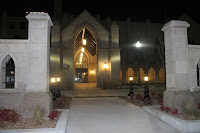This larger than life sculpture by Robert Summers depicts the family of Cyrus Avery, known as the "father of the Mother Road, Route 66" riding in their Model T and encountering a horse-drawn carriage on it's way into the city from the oil fields west of Tulsa. It's a good example of how this cosmopolitan city respects it's historic landmarks while in the process of renovating, reinventing, revitalizing and restoring itself.
We arrived in Tulsa yesterday afternoon at a surburban Elks Lodge that offers RV parking with electric. We were immediately invited to join them for dinner, Ham & Beans which neither of us has eaten in years. It was nice to socialize and discuss potential "must-sees" with local residents.
This morning, sunny and a bit warmer, we headed to downtown to explore. The new BOK Center, a multi-use sports and entertainment facility, is across the street from the Convention Center which also hosts a basketball team. The ONEOK Field is the home of the Tulsa Drillers, celebrating 100 years of professional baseball in Tulsa.
Downtown's Brady and Blue Knob districts show how older sections of a city can become new again.The JoeBot Coffee Bar was like a West Coast Experience in the Midwest. Cain's dancing hall dates back to the 1920's, often referred to as the Carnegie Hall of Country Music. It's wooden dance floor is truck spring mounted, and today serves many music genres to sell-out crowds.
And here's Tulsa at Night :


The two above are the Boston St United Methodist and the First Presbyterian Churchs, respectively. Both are magnificent cathedral style structures.








No comments:
Post a Comment